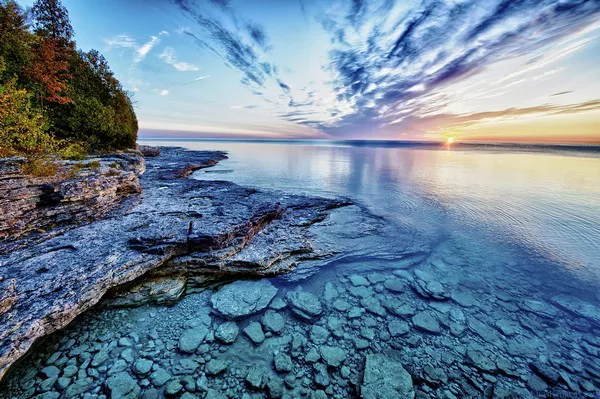Water, covering approximately 71% of the Earth’s surface, is a vital component of our planet’s ecosystems. From vast oceans to expansive lakes and winding rivers, water plays a crucial role in shaping landscapes, supporting biodiversity, and sustaining life. In this article, we will delve into the five countries with the largest water area, exploring their diverse aquatic environments and the significance of water resources within their borders.
Top 5 Countries with the Largest Water Area
1. Canada
Total Water Area: Approximately 891,163 square kilometers
Canada, known for its breathtaking natural landscapes and abundant freshwater resources, boasts the largest water area of any country in the world. With its extensive network of rivers, lakes, and coastal waters, water plays a fundamental role in shaping Canada’s geography, economy, and culture.
The country is home to numerous iconic bodies of water, including the Great Lakes, which form the largest group of freshwater lakes on Earth. These interconnected lakes – Superior, Michigan, Huron, Erie, and Ontario – not only provide valuable freshwater resources but also support diverse ecosystems and recreational activities.
In addition to its inland waters, Canada is bordered by three major oceans: the Atlantic, Pacific, and Arctic. These vast marine environments support a rich diversity of marine life, including whales, seals, and fish species.
Water management and conservation are critical priorities for Canada, given the importance of freshwater resources for agriculture, industry, and communities across the country. Efforts to protect water quality, mitigate pollution, and address issues such as climate change and habitat loss are ongoing, reflecting Canada’s commitment to sustainable water management.
2. United States
Total Water Area: Approximately 664,709 square kilometers
The United States, with its diverse geography and extensive coastline, ranks among the top countries in terms of water area. From the mighty Mississippi River to the expansive Great Lakes and the vast coastal waters of the Atlantic and Pacific Oceans, water plays a central role in shaping the American landscape and supporting a wide range of ecosystems and human activities.
The Great Lakes, shared with Canada, are a defining feature of the North American continent. These interconnected bodies of water not only serve as a vital freshwater resource but also support a thriving maritime industry, recreational boating, and tourism.
The United States is also home to numerous rivers, including the Mississippi, Missouri, Colorado, and Columbia, which play a crucial role in transportation, irrigation, and hydroelectric power generation.
Coastal areas, including the Gulf of Mexico, Chesapeake Bay, and Puget Sound, are characterized by rich biodiversity, productive fisheries, and vibrant coastal communities.
Water management and conservation are key priorities for the United States, with efforts focused on improving water quality, protecting sensitive ecosystems, and ensuring sustainable water use in the face of growing demand and climate change.
3. Russia
Total Water Area: Approximately 632,089 square kilometers
Russia, the world’s largest country by land area, also boasts significant water resources, including vast rivers, lakes, and extensive coastline along the Arctic and Pacific Oceans.
The country’s extensive network of rivers, including the Volga, Lena, and Yenisei, plays a crucial role in transporting goods, generating hydroelectric power, and supporting agriculture and industry.
Russia is also home to numerous lakes, including Lake Baikal, the world’s deepest and oldest freshwater lake, and the Caspian Sea, the largest inland body of water on Earth.
The Arctic Ocean, which borders Russia’s northern coastline, is of strategic importance due to its vast energy and mineral resources, as well as its growing significance for shipping and trade as Arctic sea ice melts.
Water management and conservation efforts in Russia are focused on addressing pollution, improving infrastructure, and protecting sensitive ecosystems, particularly in the Arctic region, where climate change is having a profound impact on the environment.
4. Brazil
Total Water Area: Approximately 579,364 square kilometers
Brazil, home to the world’s largest tropical rainforest and extensive river systems, ranks among the top countries in terms of water area. The Amazon River basin, the largest river basin in the world, encompasses approximately one-fifth of Brazil’s territory and is home to unparalleled biodiversity and ecological importance.
The Amazon River, along with its tributaries, plays a crucial role in regulating the global climate, storing carbon, and supporting indigenous communities and traditional ways of life.
In addition to the Amazon, Brazil is home to other major river systems, including the Paraná, São Francisco, and Tocantins rivers, which support agriculture, transportation, and hydroelectric power generation.
Brazil’s extensive coastline, stretching over 7,000 kilometers along the Atlantic Ocean, is characterized by diverse ecosystems, including mangrove forests, coral reefs, and sandy beaches.
Water management and conservation efforts in Brazil are focused on addressing deforestation, land degradation, and pollution in the Amazon basin, as well as improving access to clean water and sanitation services for rural and marginalized communities.
5. China
Total Water Area: Approximately 344,750 square kilometers
China, with its vast territory and diverse landscapes, ranks among the top countries in terms of water area. The country’s extensive river systems, including the Yangtze, Yellow, and Pearl rivers, play a crucial role in supporting agriculture, industry, and transportation.
The Yangtze River, the longest river in Asia, is a lifeline for millions of people living in its basin and supports a wide range of economic activities, including shipping, fishing, and tourism.
China’s coastline, stretching over 14,000 kilometers along the Pacific Ocean, is characterized by dynamic coastal environments, including estuaries, mangrove forests, and sandy beaches.
Water management and conservation efforts in China are focused on addressing pollution, improving water quality, and enhancing water resource management in the face of growing demand and climate change.
See Also: 10 Most Powerful Countries In Asia
In conclusion, the five countries with the largest water area – Canada, the United States, Russia, Brazil, and China – are characterized by diverse aquatic environments, ranging from vast rivers and lakes to extensive coastlines and marine ecosystems. Water plays a fundamental role in shaping landscapes, supporting biodiversity, and sustaining human activities in these countries, highlighting the importance of water management and conservation efforts for the health and well-being of both people and the planet.
You Might Be Interested In:
























